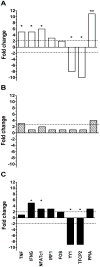In utero activation of fetal memory T cells alters host regulatory gene expression and affects HIV susceptibility
- PMID: 22280894
- PMCID: PMC3725764
- DOI: 10.1016/j.virol.2012.01.003
In utero activation of fetal memory T cells alters host regulatory gene expression and affects HIV susceptibility
Abstract
In utero priming to malaria antigens renders cord blood mononuclear cells (CBMC) more susceptible to productive HIV infection in vitro in the absence of exogenous stimulation. This provides a unique model to better understand mechanisms affecting lymphocyte susceptibility to HIV infection in vivo. Effector memory CD3(+)CD4(+) T cells (T(EM)) were the exclusive initial targets of HIV with rapid spread to central memory cells. HIV susceptibility correlated with increased expression of CD25 and HLA-DR on T(EM). Virus entered all samples equally, however gag/pol RNA was only detected in HIV susceptible samples, suggesting regulation of proviral gene transcription. Targeted analysis of human genes in memory T cells showed greater expression of IFNG, NFATc1, IRF1, FOS, and PPIA and decreased expression YY1 and TFCP2 in HIV susceptible samples. Thus fetal priming to exogenous antigens enhances specific proviral gene transcription pathways in effector memory cells that may increase risk of vertical transmission of HIV.
Published by Elsevier Inc.
Figures





Similar articles
-
A parameter for IL-10 and TGF-ß mediated regulation of HIV-1 specific T cell activation provides novel information and relates to progression markers.PLoS One. 2014 Jan 9;9(1):e85604. doi: 10.1371/journal.pone.0085604. eCollection 2014. PLoS One. 2014. PMID: 24416431 Free PMC article.
-
Innate and adaptive immune responses both contribute to pathological CD4 T cell activation in HIV-1 infected Ugandans.PLoS One. 2011 Apr 19;6(4):e18779. doi: 10.1371/journal.pone.0018779. PLoS One. 2011. PMID: 21526194 Free PMC article.
-
Preserved central memory and activated effector memory CD4+ T-cell subsets in human immunodeficiency virus controllers: an ANRS EP36 study.J Virol. 2007 Dec;81(24):13904-15. doi: 10.1128/JVI.01401-07. Epub 2007 Oct 10. J Virol. 2007. PMID: 17928341 Free PMC article.
-
The role of dendritic cells in the pathogenesis of HIV-1 infection.APMIS. 2003 Jul-Aug;111(7-8):776-88. doi: 10.1034/j.1600-0463.2003.11107809.x. APMIS. 2003. PMID: 12974779 Review.
-
Comprehensive Mass Cytometry Analysis of Cell Cycle, Activation, and Coinhibitory Receptors Expression in CD4 T Cells from Healthy and HIV-Infected Individuals.Cytometry B Clin Cytom. 2017 Jan;92(1):21-32. doi: 10.1002/cyto.b.21502. Cytometry B Clin Cytom. 2017. PMID: 27997758 Review.
Cited by
-
Cytomegalovirus upregulates expression of CCR5 in central memory cord blood mononuclear cells, which may facilitate in utero HIV type 1 transmission.J Infect Dis. 2015 Jan 15;211(2):187-96. doi: 10.1093/infdis/jiu424. Epub 2014 Jul 31. J Infect Dis. 2015. PMID: 25081935 Free PMC article.
-
Hyperparasitaemia during clinical malaria episodes in infants aged 0-24 months and its association with in utero exposure to Plasmodium falciparum.BMC Res Notes. 2018 Apr 4;11(1):232. doi: 10.1186/s13104-018-3339-0. BMC Res Notes. 2018. PMID: 29618382 Free PMC article.
-
Impact of HIV-1 infection on the feto-maternal crosstalk and consequences for pregnancy outcome and infant health.Semin Immunopathol. 2016 Nov;38(6):727-738. doi: 10.1007/s00281-016-0578-9. Epub 2016 Jul 8. Semin Immunopathol. 2016. PMID: 27392971 Review.
-
Effect of helminth-induced immunity on infections with microbial pathogens.Nat Immunol. 2013 Nov;14(11):1118-1126. doi: 10.1038/ni.2736. Nat Immunol. 2013. PMID: 24145791 Free PMC article. Review.
References
-
- Ahmad N, Mehta R, Harris DT. HIV-1 replication and gene expression occur at higher levels in neonatal blood naive and memory T-lymphocytes compared with adult blood cells. Virology. 2011;413(1):39–46. - PubMed
-
- Battistini A, Marsili G, Sgarbanti M, Ensoli B, Hiscott J. IRF regulation of HIV-1 long terminal repeat activity. Journal of Interferon & Cytokine Research: The Official Journal of the International Society for Interferon and Cytokine Research. 2002;22(1):27–37. - PubMed
-
- Brahmbhatt H, Kigozi G, Wabwire-Mangen F, Serwadda D, Sewankambo N, Lutalo T, Wawer MJ, Abramowsky C, Sullivan D, Gray R. The effects of placental malaria on mother-to-child HIV transmission in Rakai, Uganda. AIDS. 2003;17(17):2539–2541. - PubMed
Publication types
MeSH terms
Substances
Grants and funding
LinkOut - more resources
Full Text Sources
Medical
Research Materials
Miscellaneous

